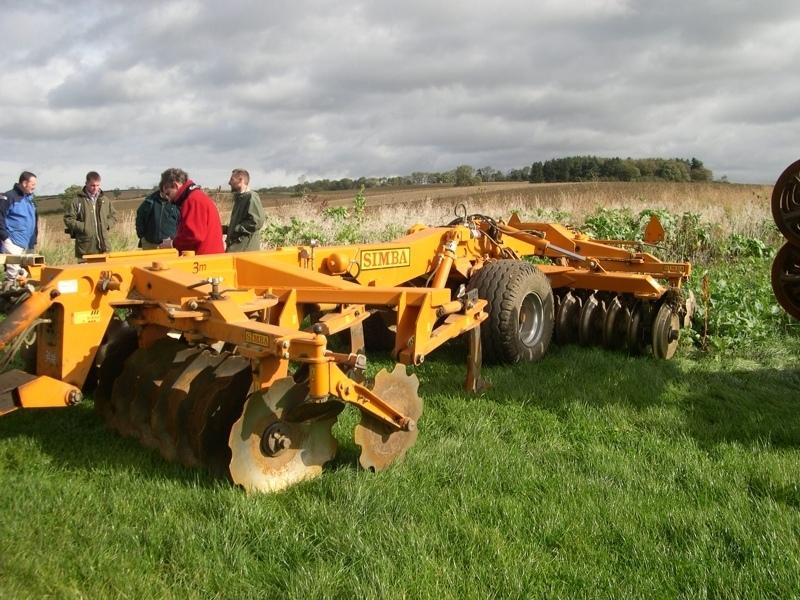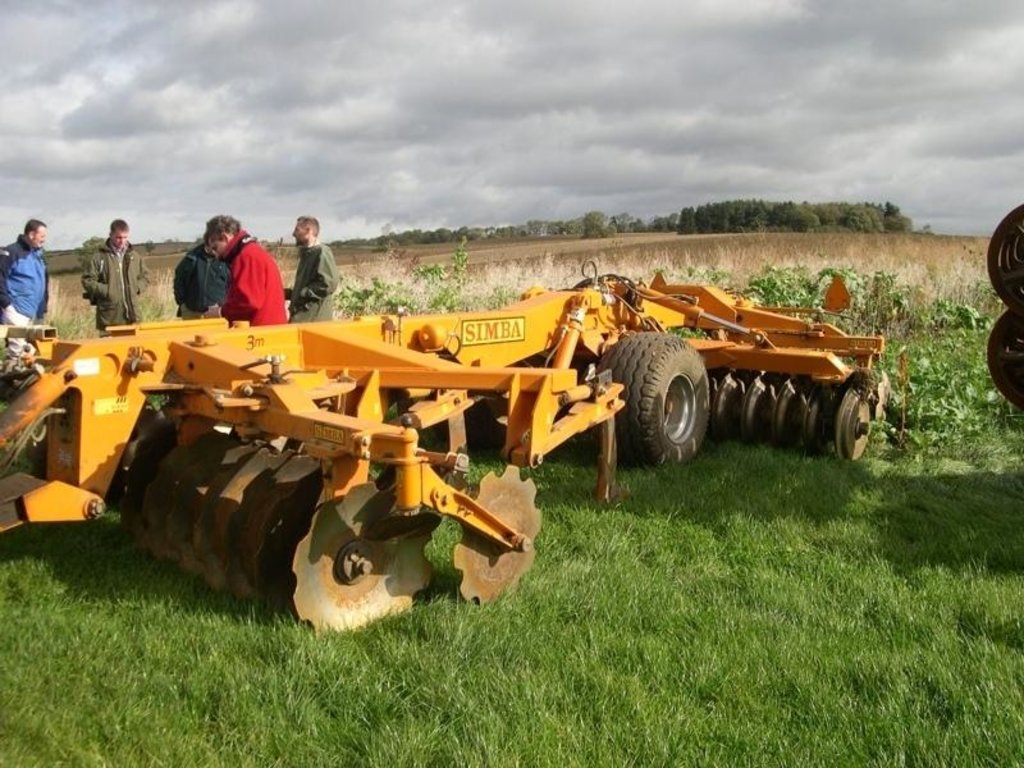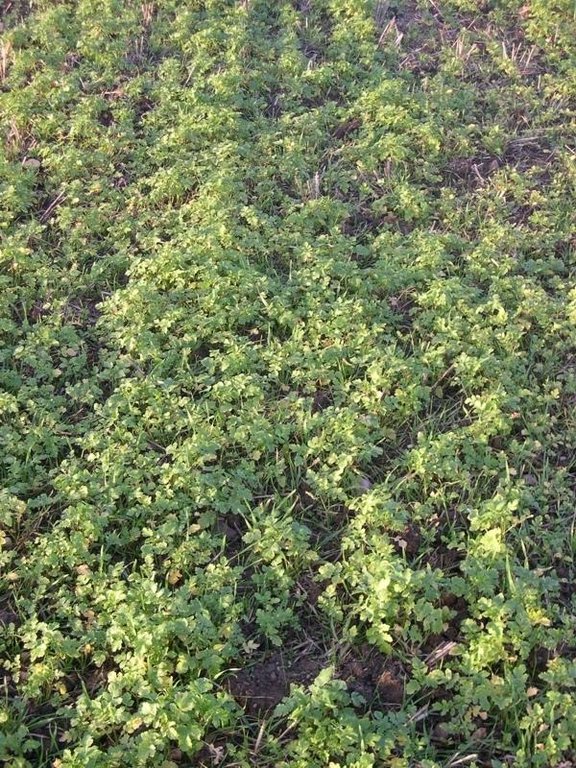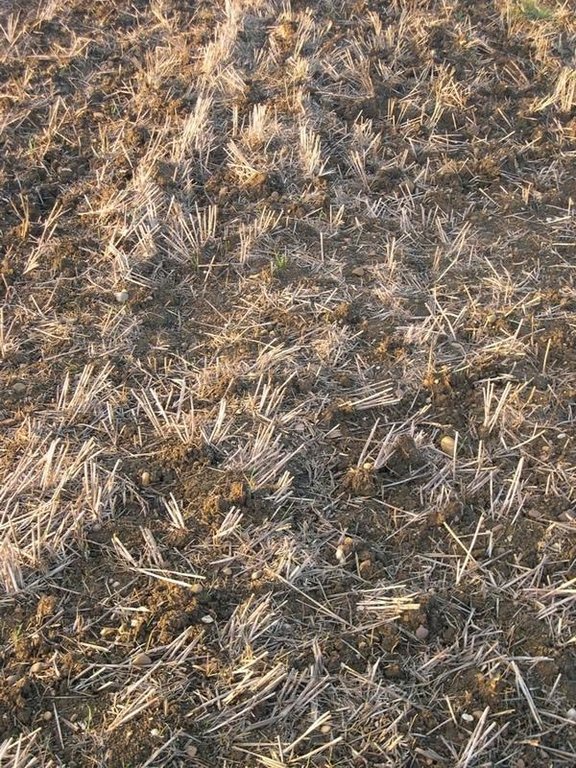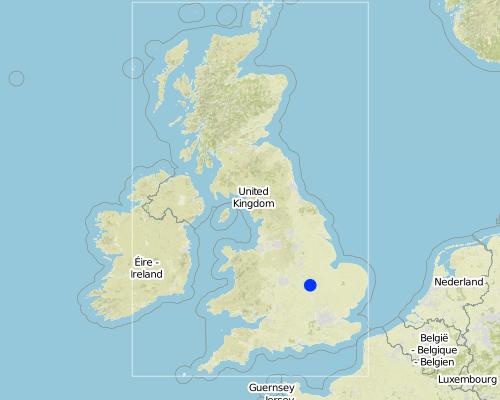Non-inversion tillage in UK arable cropping; Loddington [สหราชอาณาจักร]
- ผู้สร้างสรรค์:
- การอัพเดท:
- ผู้รวบรวม: Ceris A. Jones
- ผู้เรียบเรียง: –
- ผู้ตรวจสอบ: Fabian Ottiger
minimum tillage (English), conservation tillage (English)
technologies_986 - สหราชอาณาจักร
ดูส่วนย่อย
ขยายทั้งหมด ย่อทั้งหมด1. ข้อมูลทั่วไป
1.2 รายละเอียดที่ติดต่อได้ของผู้รวบรวมและองค์กรที่เกี่ยวข้องในการประเมินและการจัดเตรียมทำเอกสารของเทคโนโลยี
ผู้เชี่ยวชาญ SLM:
ชื่อของโครงการซึ่งอำนวยความสะดวกในการทำเอกสารหรือการประเมินเทคโนโลยี (ถ้าเกี่ยวข้อง)
Soil and water protection (EU-SOWAP)ชื่อขององค์กรซึ่งอำนวยความสะดวกในการทำเอกสารหรือการประเมินเทคโนโลยี (ถ้าเกี่ยวข้อง)
Game & Wildlife Conservation Trust - สหราชอาณาจักร1.3 เงื่อนไขการใช้ข้อมูลที่ได้บันทึกผ่านทาง WOCAT
วันที่เก็บรวบรวมข้อมูล(ภาคสนาม) :
02/11/2004
ผู้รวบรวมและวิทยากรหลักยอมรับเงื่อนไขเกี่ยวกับการใช้ข้อมูลที่ถูกบันทึกผ่านทาง WOCAT:
ใช่
1.5 อ้างอิงไปที่แบบสอบถามเรื่องแนวทาง SLM
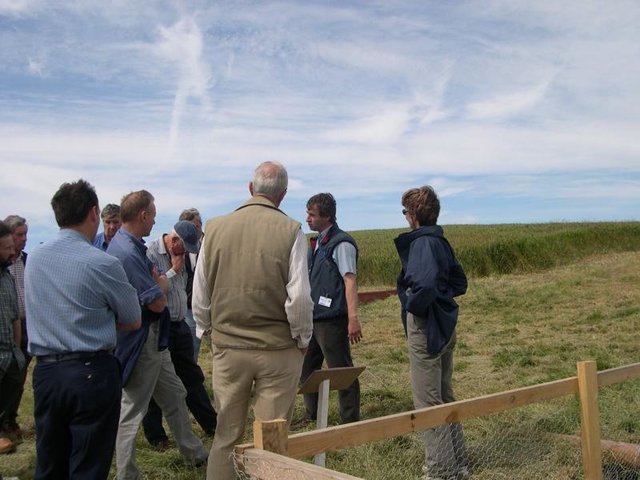
Participatory on-farm demonstration in UK arable cropping: Loddington [สหราชอาณาจักร]
Provision of expert knowledge in appropriating equipment and setting up small scale on farm trials in collaboration with the land manager
- ผู้รวบรวม: Ceris A. Jones
2. การอธิบายลักษณะของเทคโนโลยี SLM
2.1 การอธิบายแบบสั้น ๆ ของเทคโนโลยี
คำจำกัดความของเทคโนโลยี:
Surface cultivation of the top 10cm of soil but not complete inversion
2.2 การอธิบายแบบละเอียดของเทคโนโลยี
คำอธิบาย:
machinery with discs or tines replace the plough.
Purpose of the Technology: (i) improved crop establishment particularly by speeding up of operations (ii) improved soil structure.
Establishment / maintenance activities and inputs: appropriate machinery, soil condition and following crop all determine establishment.
Maintenance: on an annual basis.
Natural / human environment: farmer working to protect environment and maintain rural employment
2.3 รูปภาพของเทคโนโลยี
2.5 ประเทศภูมิภาค หรือสถานที่ตั้งที่เทคโนโลยีได้นำไปใช้และได้รับการครอบคลุมโดยการประเมินนี้
ประเทศ:
สหราชอาณาจักร
ภูมิภาค/รัฐ/จังหวัด:
Leicestershire
ข้อมูลจำเพาะเพิ่มเติมของสถานที่ตั้ง :
Loddington
Map
×2.7 คำแนะนำของเทคโนโลยี
ความคิดเห็น (ประเภทของโครงการ เป็นต้น) :
From the USA where in te 1930's the 'dust-bowls' necessitated the development of soil conservation in intensive agriculture
3. การจัดประเภทของเทคโนโลยี SLM
3.2 ประเภทของการใช้ที่ดินในปัจจุบันที่ได้นำเทคโนโลยีไปใช้

พื้นที่ปลูกพืช
- การปลูกพืชล้มลุกอายุปีเดียว
พืชหลัก (พืชเศรษฐกิจและพืชอาหาร):
Major cash crop: Wheat
Other crops: Oilseed rape, beans
แสดงความคิดเห็น:
Major land use problems (compiler’s opinion): Water turbidity, compaction, erosion
Major land use problems (land users’ perception): Compaction
Type of cropping system and major crops comments: wheat - oilseed rape - wheat - beans. Typically these will be winter-sown (Sept) crops rather than spring sown (March)
3.3 ข้อมูลเพิ่มเติมเกี่ยวกับการใช้ที่ดิน
การใช้น้ำของที่ดินที่มีการใช้เทคโนโลยีอยู่:
- จากน้ำฝน
จำนวนของฤดูเพาะปลูกต่อปี:
- 1
ระบุ:
Longest growing period in days: 330Longest growing period from month to month: Sep - Aug
3.4 กลุ่ม SLM ที่ตรงกับเทคโนโลยีนี้
- การรบกวนดินให้น้อยที่สุด
3.5 กระจายตัวของเทคโนโลยี
แสดงความคิดเห็น:
Total area covered by the SLM Technology is 1.46 m2.
This represents 60% of the total arable area on the farm
3.6 มาตรการ SLM ที่ประกอบกันเป็นเทคโนโลยี
3.7 รูปแบบหลักของการเสื่อมโทรมของที่ดินที่ได้รับการแก้ไขโดยเทคโนโลยี

การกัดกร่อนของดินโดยน้ำ
- Wt (Loss of topsoil): การสูญเสียดินชั้นบนหรือการกัดกร่อนที่ผิวดิน
- Wo (Offsite degradation): ผลกระทบนอกพื้นที่

การเสื่อมโทรมของดินทางด้านเคมี
- Cn (Fertility decline): ความอุดมสมบูรณ์และปริมาณอินทรียวัตถุในดินถูกทำให้ลดลงไป (ไม่ได้เกิดจากสาเหตุการกัดกร่อน)

การเสื่อมโทรมของดินทางด้านกายภาพ
- Pc (Compaction): การอัดแน่น
แสดงความคิดเห็น:
Main type of degradation addressed: Pc: compaction
Secondary types of degradation addressed: Wt: loss of topsoil / surface erosion, Wo: offsite degradation effects, Cn: fertility decline and reduced organic matter content
Main causes of degradation: other human induced causes (specify) (agricultural causes), education, access to knowledge and support services (lack of knowledge)
3.8 การป้องกัน การลดลง หรือการฟื้นฟูความเสื่อมโทรมของที่ดิน
ระบุเป้าหมายของเทคโนโลยีกับความเสื่อมโทรมของที่ดิน:
- ป้องกันความเสื่อมโทรมของที่ดิน
- ลดความเสื่อมโทรมของดิน
แสดงความคิดเห็น:
Main goals: mitigation / reduction of land degradation
Secondary goals: prevention of land degradation
4. ข้อมูลจำเพาะด้านเทคนิค กิจกรรมการนำไปปฏิบัติใช้ ปัจจัยนำเข้า และค่าใช้จ่าย
4.2 ข้อมูลจำเพาะด้านเทคนิคและการอธิบายแบบแปลนทางเทคนิค
Technical knowledge required for field staff / advisors: moderate
Technical knowledge required for land users: high
Main technical functions: control of dispersed runoff: impede / retard
Secondary technical functions: control of raindrop splash, control of concentrated runoff: impede / retard, improvement of ground cover, increase in organic matter, increase of infiltration, increase / maintain water stored in soil, improvement of soil structure, increase in soil fertility
Mulching
Material/ species: crop residue
Quantity/ density: 5 t/ha
Remarks: dispersed over soil surface
Mineral (inorganic) fertilizers
Material/ species: NPK
Quantity/ density: 0.14 t/ha
Remarks: broadcast
Rotations / fallows
Material/ species: cereals/ broad-leaved crops
Remarks: alternate years
Breaking compacted topsoil
Remarks: localised
Minimum tillage
Remarks: using discs and tines
Breaking compacted subsoil
Remarks: localised
Deep tillage / double digging
Remarks: localised
4.3 ข้อมูลทั่วไปเกี่ยวกับการคำนวณปัจจัยนำเข้าและค่าใช้จ่าย
อื่นๆ หรือสกุลเงินประจำชาติ (ระบุ):
UK pounds (£)
ระบุอัตราแลกเปลี่ยนจากดอลลาร์สหรัฐเป็นสกุลเงินท้องถิ่น (ถ้าเกี่ยวข้อง) คือ 1 เหรียญสหรัฐ =:
0.56
ระบุค่าเฉลี่ยของค่าจ้างในการจ้างแรงงานต่อวัน:
155.00
4.6 การบำรุงรักษาสภาพหรือกิจกรรมที่เกิดขึ้นเป็นประจำ
| กิจกรรม | ประเภทของมาตรการ | ช่วงระยะเวลา/ความถี่ | |
|---|---|---|---|
| 1. | Year1: chop straw as low to the ground as possible | จัดการพืช | at harvest (usually August) / annual |
| 2. | Year1: incorporate straw to 10cm depth, though this is dependent on density of straw | จัดการพืช | September / per crop |
| 3. | Year1: additional cultivation | จัดการพืช | early October / per crop |
| 4. | Year1:drilling (4cm depth) | จัดการพืช | early October / once per crop |
| 5. | Year1: consolidation (more in Annex 3) | จัดการพืช | early October / once per crop |
4.7 ค่าใช้จ่ายของปัจจัยนำเข้าและกิจกรรมที่เกิดขึ้นเป็นประจำที่ต้องการการบำรุงรักษา (ต่อปี)
| ปัจจัยนำเข้า | หน่วย | ปริมาณ | ค่าใช้จ่ายต่อหน่วย | ค่าใช้จ่ายทั้งหมดต่อปัจจัยนำเข้า | %ของค่าใช้จ่ายที่ก่อให้เกิดขึ้นโดยผู้ใช้ที่ดิน | |
|---|---|---|---|---|---|---|
| อุปกรณ์ | Machine use | ha | 1.0 | 204.0 | 204.0 | 100.0 |
| อุปกรณ์ | Machine hours (year 2) | ha | 1.0 | 184.0 | 184.0 | 100.0 |
| อุปกรณ์ | Machine hours (year 3) | ha | 1.0 | 236.0 | 236.0 | 100.0 |
| ค่าใช้จ่ายทั้งหมดของการบำรุงรักษาสภาพเทคโนโลยี | 624.0 | |||||
แสดงความคิดเห็น:
Machinery/ tools: Simba Solo, Cambridge rollers, Vaderstad drill
Per hectare of land where technology applied. The costs represent the total crop establishment costs (machinery + labour) for this technology. Other costs eg seeds, fertiliser, are not included as these are identical to those incurred by other technologies (UNK1b) at this farm. These costs are related to the prevailing conditions - crop type, state of the soil, climate etc. Crop establishment costs by ploughing were: 224 (year1), 204 (year2), 263 (year3)
Additional info: - Year2: chop straw as low to the ground as possible: after harvest / annual - Year2:incorporate straw to 10cm depth, though this is dependent on density of straw: September / per crop - Year2: additional cultivation: March / per crop - Year2: drilling (2.5-4cm depth): March / once per crop - Year3:chop straw as low to the ground as possible: after harvest / annual - Year3: incorporate straw and relieve compaction of soil: October / per crop - Year3: additional cultivation: October / per crop - Year3: drill (2.5-4cm depth): October / once per crop - Year3: consolidation: October / once per crop
4.8 ปัจจัยสำคัญที่สุดที่มีผลกระทบต่อค่าใช้จ่าย
ปัจจัยสำคัญที่สุดที่มีผลกระทบต่อค่าใช้จ่ายต่างๆ:
Equipment costs, slope (higher horse power required for steeper slopes), presence of weeds (higher herbicide costs),
5. สิ่งแวดล้อมทางธรรมชาติและของมนุษย์
5.1 ภูมิอากาศ
ฝนประจำปี
- < 250 ม.ม.
- 251-500 ม.ม.
- 501-750 ม.ม.
- 751-1,000 ม.ม.
- 1,001-1,500 ม.ม.
- 1,501-2,000 ม.ม.
- 2,001-3,000 ม.ม.
- 3,001-4,000 ม.ม.
- > 4,000 ม.ม.
ระบุปริมาณน้ำฝนเฉลี่ยรายปี (ถ้ารู้) :หน่วย ม.ม.
660.00
เขตภูมิอากาศเกษตร
- กึ่งชุ่มชื้น
5.2 สภาพภูมิประเทศ
ค่าเฉลี่ยความลาดชัน:
- ราบเรียบ (0-2%)
- ลาดที่ไม่ชัน (3-5%)
- ปานกลาง (6-10%)
- เป็นลูกคลื่น (11-15%)
- เป็นเนิน (16-30%)
- ชัน (31-60%)
- ชันมาก (>60%)
ธรณีสัณฐาน:
- ที่ราบสูง/ที่ราบ
- สันเขา
- ไหล่เขา
- ไหล่เนินเขา
- ตีนเนิน
- หุบเขา
ระดับความสูง:
- 0-100 เมตร
- 101-500 เมตร
- 501-1,000 เมตร
- 1,001-1,500 เมตร
- 1,501-2,000 เมตร
- 2,001-2,500 เมตร
- 2,501-3,000 เมตร
- 3,001-4,000 เมตร
- > 4,000 เมตร
ความคิดเห็นและข้อมูลจำเพาะเพิ่มเติมเรื่องสภาพภูมิประเทศ:
Landforms: Hill slopes (some slopes < 8%)
5.3 ดิน
ค่าเฉลี่ยความลึกของดิน:
- ตื้นมาก (0-20 ซ.ม.)
- ตื้น (21-50 ซ.ม.)
- ลึกปานกลาง (51-80 ซ.ม.)
- ลึก (81-120 ซ.ม.)
- ลึกมาก (>120 ซ.ม.)
เนื้อดิน (ดินชั้นบน):
- ปานกลาง (ดินร่วน ทรายแป้ง)
- ละเอียด/หนัก (ดินเหนียว)
อินทรียวัตถุในดิน:
- ปานกลาง (1-3%)
(ถ้ามี) ให้แนบคำอธิบายเรื่องดินแบบเต็มหรือระบุข้อมูลที่มีอยู่ เช่น ชนิดของดิน ค่า pH ของดินหรือความเป็นกรดของดิน ความสามารถในการแลกเปลี่ยนประจุบวก ไนโตรเจน ความเค็ม เป็นต้น:
Soil fertility is medium
Soil drainage/infiltration is good
Soil water storage capacity is high
5.6 ลักษณะของผู้ใช้ที่ดินที่นำเทคโนโลยีไปปฏิบัติใช้
แนวทางการตลาดของระบบการผลิต:
- ทำการค้า/การตลาด
รายได้ที่มาจากนอกฟาร์ม:
- 10-50% ของรายได้ทั้งหมด
ระดับของความมั่งคั่งโดยเปรียบเทียบ:
- พอมีพอกิน
ระดับของการใช้เครื่องจักรกล:
- การใช้เครื่องจักรหรือเครื่องยนต์
ระบุลักษณะอื่นๆที่เกี่ยวข้องของผู้ใช้ที่ดิน:
Population density: 10-50 persons/km2
Annual population growth: 1% - 2%
50% of the land users are rich and own 60% of the land.
50% of the land users are average wealthy and own 40% of the land.
Off-farm income specification: The time saved by practising non-inversion tillage (52 minutes/ha) allows the land manager to undertake contracted work on other farms
5.7 พื้นที่เฉลี่ยของที่ดินที่เป็นเจ้าของหรือเช่าโดยผู้ใช้ที่ดินที่นำเทคโนโลยีไปปฏิบัติใช้
- < 0.5 เฮกตาร์
- 0.5-1 เฮกตาร์
- 1-2 เฮกตาร์
- 2-5 เฮกตาร์
- 5-15 เฮกตาร์
- 15-50 เฮกตาร์
- 50-100 เฮกตาร์
- 100-500 เฮกตาร์
- 500-1,000 เฮกตาร์
- 1,000-10,000 เฮกตาร์
- >10,000 เฮกตาร์
แสดงความคิดเห็น:
250 ha of cultivated arable land
5.8 กรรมสิทธิ์ในที่ดิน สิทธิในการใช้ที่ดินและสิทธิในการใช้น้ำ
- Trust
- Trust
- Trust
6. ผลกระทบและสรุปคำบอกกล่าว
6.1 ผลกระทบในพื้นที่ดำเนินการ (On-site) จากการใช้เทคโนโลยี
ผลกระทบทางด้านเศรษฐกิจและสังคม
การผลิต
การผลิตพืชผล
แสดงความคิดเห็น/ระบุ:
In good (weather) conditions, yields from ploughed fields often better
รายได้และค่าใช้จ่าย
รายได้จากฟาร์ม
ผลกระทบทางด้านเศรษฐกิจและสังคมอื่น ๆ
timeliness of operations
แสดงความคิดเห็น/ระบุ:
Speed of working allows larger acreage to be managed
Input constraints
แสดงความคิดเห็น/ระบุ:
herbicide resistance is increasing in a number of weed species therefore a better range of herbicide options required
Window of operation
แสดงความคิดเห็น/ระบุ:
Can be more narrow than when ploughing
ผลกระทบด้านนิเวศวิทยา
วัฐจักรน้ำหรือน้ำบ่า
การระบายน้ำส่วนเกิน
แสดงความคิดเห็น/ระบุ:
Better infiltration of water
ดิน
ความชื้นในดิน
แสดงความคิดเห็น/ระบุ:
Better germination in dry years
สิ่งปกคลุมดิน
แสดงความคิดเห็น/ระบุ:
Crop residue
การสูญเสียดิน
จำนวนก่อน SLM:
0.01
หลังจาก SLM:
0
แสดงความคิดเห็น/ระบุ:
Better soil structure
ผลกระทบด้านนิเวศวิทยาอื่น ๆ
Maintenance of rural employment
แสดงความคิดเห็น/ระบุ:
enabled the farm to just about support the land manager and farm worker
Soil fertility
แสดงความคิดเห็น/ระบุ:
Higher organic matter levels
Biodiversity enhancement
แสดงความคิดเห็น/ระบุ:
Higher bird and invertebrate numbers
6.2 ผลกระทบนอกพื้นที่ดำเนินการ (Off-site) จากการใช้เทคโนโลยี
การไหลของน้ำคงที่และสม่ำเสมอในช่วงฤดูแล้ง
น้ำท่วมพื้นที่ท้ายน้ำ
การทับถมของดินตะกอนพื้นที่ท้ายน้ำ
การเกิดมลพิษในน้ำบาดาลหรือแม่น้ำ
แสดงความคิดเห็น/ระบุ:
Fertilisers and pesticides not transported with eroded soil, better soil structure + biodiversity slow + improve metabolism of chemicals in the soil
6.4 การวิเคราะห์ค่าใช้จ่ายและผลประโยชน์ที่ได้รับ
ผลประโยชน์ที่ได้รับเปรียบเทียบกับค่าใช้จ่ายในการจัดตั้งเป็นอย่างไร (จากมุมมองของผู้ใช้ที่ดิน)
ผลตอบแทนระยะสั้น:
ด้านลบเล็กน้อย
ผลตอบแทนระยะยาว:
ด้านบวกเล็กน้อย
ผลประโยชน์ที่ได้รับเปรียบเทียบกับค่าใช้จ่ายในการบำรุงรักษาหรือต้นทุนที่เกิดขึ้นซ้ำอีก เป็นอย่างไร (จากมุมมองของผู้ใช้ที่ดิน)
ผลตอบแทนระยะสั้น:
เป็นกลางหรือสมดุล
ผลตอบแทนระยะยาว:
เป็นกลางหรือสมดุล
6.5 การปรับตัวของเทคโนโลยี
จากทั้งหมดที่ได้รับเทคโนโลยีเข้ามามีจำนวนเท่าใดที่ทำแบบทันที โดยไม่ได้รับการจูงใจด้านวัสดุหรือการเงินใด ๆ:
- 90-100%
แสดงความคิดเห็น:
100% of land user families have adopted the Technology without any external material support
1 land user families have adopted the Technology without any external material support
Comments on spontaneous adoption: survey results
There is a little trend towards spontaneous adoption of the Technology
Comments on adoption trend: Currently 40% of UK farmers practice non-inversion tillage mainly for economic reasons
6.7 จุดแข็ง / ข้อได้เปรียบ / โอกาสของเทคโนโลยี
| จุดแข็ง / ข้อได้เปรียบ / โอกาสในทัศนคติของผู้ใช้ที่ดิน |
|---|
|
Timely crop establishment + good work rate How can they be sustained / enhanced? good planning |
|
Lower costs How can they be sustained / enhanced? Increased acreage to spread costs |
|
Increased contractor income How can they be sustained / enhanced? as above |
|
improved soil structure - higher organic matter and provision of a better seed bed to drill into How can they be sustained / enhanced? continue with practice |
| จุดแข็ง / ข้อได้เปรียบ / โอกาสในทัศนคติของผู้รวบรวมหรือวิทยากรหลัก |
|---|
|
cost effectiveness How can they be sustained / enhanced? increase ares under cultivation (economy of scale) |
| increased work rate |
|
improved soil quality How can they be sustained / enhanced? continuation of current soil management principles |
|
increased biodiversity How can they be sustained / enhanced? price premium for biodiversity-friendly products |
|
improved water quality How can they be sustained / enhanced? no option. The EU Water Framework Directive requires watercourses to be of good status by 2015 |
6.8 จุดอ่อน / ข้อเสียเปรียบ / ความเสี่ยงของเทคโนโลยีและวิธีการแก้ไข
| จุดอ่อน / ข้อเสียเปรียบ / ความเสี่ยงในทัศนคติของผู้ใช้ที่ดิน | มีวิธีการแก้ไขได้อย่างไร |
|---|---|
| narrow weather window | drill non-inversion tillage fields first |
| grass weeds | crop rotation; new herbicide modes of action |
| slug management | monitoring slug populations |
| large acreage required to justify cost of machinery | consider not cropping headlands |
| จุดอ่อน / ข้อเสียเปรียบ / ความเสี่ยงในทัศนคติของผู้รวบรวมหรือวิทยากรหลัก | มีวิธีการแก้ไขได้อย่างไร |
|---|---|
| Grass weed control | New herbicide modes of action, more integrated management options |
| Untidy appearance of field (due to crop residue) | Familiarity with the technology |
7. การอ้างอิงและการเชื่อมต่อ
7.2 การอ้างอิงถึงสิ่งตีพิมพ์
หัวข้อ, ผู้เขียน, ปี, หมายเลข ISBN:
Guide to managing crop establishment, SMI
ชื่อเรื่อง ผู้เขียน ปี ISBN:
www.smi.org.uk
หัวข้อ, ผู้เขียน, ปี, หมายเลข ISBN:
Improved soil management for agronomic and environmental gain, SMI
ชื่อเรื่อง ผู้เขียน ปี ISBN:
www.smi.org.uk
หัวข้อ, ผู้เขียน, ปี, หมายเลข ISBN:
ECAF website
ชื่อเรื่อง ผู้เขียน ปี ISBN:
www.sowap.org
ลิงก์และโมดูล
ขยายทั้งหมด ย่อทั้งหมดลิงก์

Participatory on-farm demonstration in UK arable cropping: Loddington [สหราชอาณาจักร]
Provision of expert knowledge in appropriating equipment and setting up small scale on farm trials in collaboration with the land manager
- ผู้รวบรวม: Ceris A. Jones
โมดูล
ไม่มีโมดูล


